
Juan de Flandes ("John of Flanders"; c. 1460 – by 1519) was a Flemish painter active in Spain from 1496 to 1519. His actual name is unknown, although an inscription Juan Astrat on the back of one work suggests a name such as "Jan van der Straat".[1] Jan Sallaert, who became a master in Ghent in 1480, has also been suggested. He worked in the Early Netherlandish style.[2]
Life and works

He may have been born around 1460 somewhere in Flanders, Flandes in Spanish, which encompassed modern Belgium, Netherlands, Luxembourg and bordering regions of France.[3] He evidently trained in his home country, most likely in Ghent, as his work shows similarities to that of Joos van Wassenhove, Hugo van der Goes and other Ghent artists. He is only documented after he became an artist at the court of Queen Isabella I of Castile, where he is first mentioned in the accounts in October 1496. He is described as "court painter" by 1498 and continued in the queen's service until her death in 1504.[4] He likely lived in Burgos[5] and mostly painted portraits of the royal family, but also the majority of a large series of small (21.3 x 16.7 cm) panels for a polyptych altarpiece for the queen. The panels have been dispersed and the largest number of panels is in the royal collection in Madrid.[6]
After Isabella's death in 1504 Juan de Flandes turned to ecclesiastical commissions from Spanish churches, beginning in Salamanca in 1505–1507. He was later based in Palencia, where there is a large reredos in the cathedral. In Palencia, his wife was described as a widow in December 1519. The overwhelming majority of his work held in collections outside Spain dates from this later period during which he concentrated on religious themes. Panels from a large altarpiece from a Palencian church are divided between the Prado and National Gallery of Art, Washington, who have four panels each.
His works show the Early Netherlandish style of Ghent adapted to the Spanish taste and landscape, notably the requirements for groups of compartmented scenes for altarpieces. His colouring is refined, "with a preference for rather acid hues", and "while his feeling for space and light is sophisticated, a tendency to divide space into a succession of thin planes becomes a mannerism in his late works".[7]
Albrecht Dürer praised Juan de Flandes's polyptych when he was shown it by Margaret of Austria in 1521: And on Friday Lady Margaret showed me all her beautiful things. Amongst them I saw about forty small oil pictures, the like of which for precision and excellence I have never beheld.[8]
Paintings
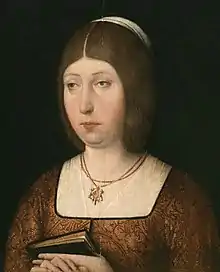
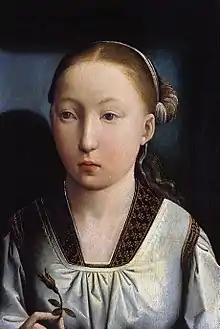

.jpg.webp) Isabella I of Castile
Isabella I of Castile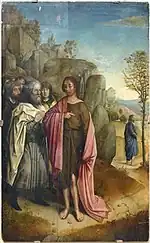 Sermon of Saint John the Baptist (1497); National Museum of Serbia (part of polyptych)
Sermon of Saint John the Baptist (1497); National Museum of Serbia (part of polyptych) Supper in the House of Simon the Pharisee (c. 1496–1504); Royal Palace, Madrid (part of the polyptych of Isabel of Castile)
Supper in the House of Simon the Pharisee (c. 1496–1504); Royal Palace, Madrid (part of the polyptych of Isabel of Castile) Christ nailed to the Cross, Vienna, also from the polyptych
Christ nailed to the Cross, Vienna, also from the polyptych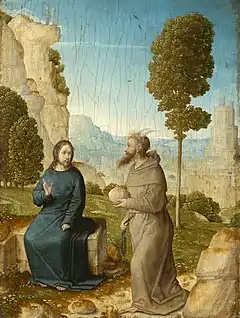 Temptation of Christ in the Wilderness, National Gallery of Art, Washington, also from the polyptych
Temptation of Christ in the Wilderness, National Gallery of Art, Washington, also from the polyptych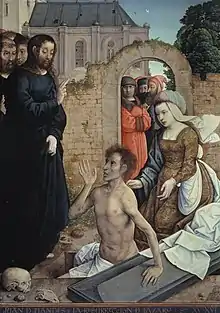 Resurrection of Lazarus, Prado, from a group for a church in Palencia.
Resurrection of Lazarus, Prado, from a group for a church in Palencia.
Notes
- ↑ Hand & Wolff, 123
- ↑ Prado, 113
- ↑ Alonso, Marco (1 December 2019). "El enigma de Juan de Flandes 500 años después de su muerte". Retrieved 11 September 2021.
- ↑ Belowzerskaya, Marina (2002). Rethinking the Renaissance: Burgundian Arts Across Europe. Cambridge University Press. pp. 171–172. ISBN 0521808502.
- ↑ Bermejo, Elisa (2002). "Dictionary of Art: Juan de Flandes". Oxford Art Online. Retrieved 31 December 2023.
- ↑ Hand & Wolff, 236-7
- ↑ Hand & Wolff, 123
- ↑ Kauffmann, C.M. "The Last Supper, with the Institution of the Eucharist and Christ Washing the Disciples' Feet". NICE Paintings - National Inventory of Continental European Paintings. Retrieved 31 December 2023.
References
- John Oliver Hand & Martha Wolff, Early Netherlandish Painting, National Gallery of Art, Washington (collection catalogue), Cambridge University Press, 1986, ISBN 0-521-34016-0
- Museo del Prado, Museo del Prado, Catálogo de las pinturas (revised edition) Ministerio de Educación y Cultura, Madrid, 1996, ISBN 84-87317-53-7
- R.van Elslande, Juan de Flandes met name Jan van der Straten, in: Brugs Ommeland, 26ste jg., 1986, nrs 1–2, blz. 111–120.